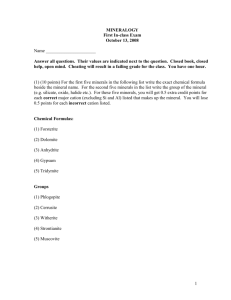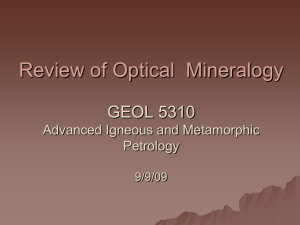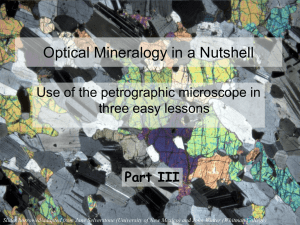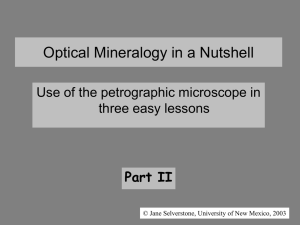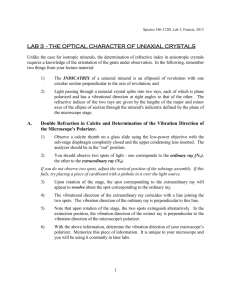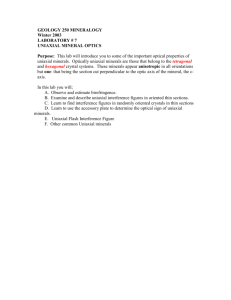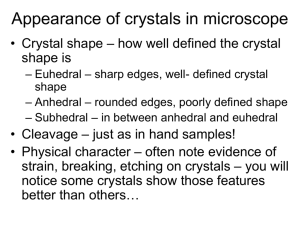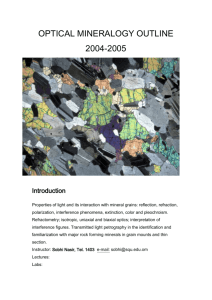Homework 04 i Part 1 Optical Mineralogy
advertisement
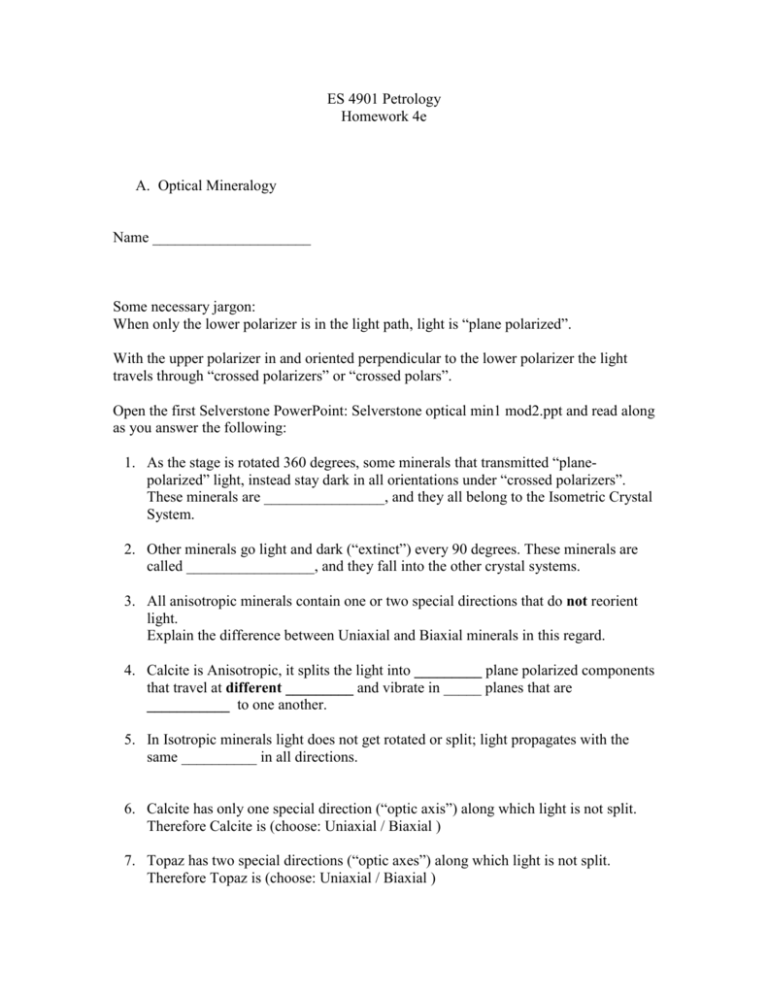
ES 4901 Petrology Homework 4e A. Optical Mineralogy Name _____________________ Some necessary jargon: When only the lower polarizer is in the light path, light is “plane polarized”. With the upper polarizer in and oriented perpendicular to the lower polarizer the light travels through “crossed polarizers” or “crossed polars”. Open the first Selverstone PowerPoint: Selverstone optical min1 mod2.ppt and read along as you answer the following: 1. As the stage is rotated 360 degrees, some minerals that transmitted “planepolarized” light, instead stay dark in all orientations under “crossed polarizers”. These minerals are ________________, and they all belong to the Isometric Crystal System. 2. Other minerals go light and dark (“extinct”) every 90 degrees. These minerals are called _________________, and they fall into the other crystal systems. 3. All anisotropic minerals contain one or two special directions that do not reorient light. Explain the difference between Uniaxial and Biaxial minerals in this regard. 4. Calcite is Anisotropic, it splits the light into _________ plane polarized components that travel at different _________ and vibrate in _____ planes that are ___________ to one another. 5. In Isotropic minerals light does not get rotated or split; light propagates with the same __________ in all directions. 6. Calcite has only one special direction (“optic axis”) along which light is not split. Therefore Calcite is (choose: Uniaxial / Biaxial ) 7. Topaz has two special directions (“optic axes”) along which light is not split. Therefore Topaz is (choose: Uniaxial / Biaxial ) 8. Make a table that lists the Crystal Systems possible for Isotropic, Uniaxial, and Biaxial minerals. 9. Define Pleochroism. 10. Suggest a way to recognize Hornblende, an Amphibole, in thin section. Look at the slides on Index of Refraction. 11. Write down the equation for Index of Refraction n in terms of velocities. 12. Define a “normal” to a surface. 13. When a light ray passes from a medium with low Index of Refraction into another medium with higher Index of Refraction, the light bends (choose: closer to the normal / further from the normal) 14. A crystal with a high Index of Refraction (e.g. Olivine) transmits light (choose: faster / slower) than a mineral with a lower Index of Refraction. 15. Thin section epoxy has an Index of Refraction of about n = 1.54 Olivine averages n=1.7 Olivine in a thin section glued to a slide with epoxy will show (choose: high positive relief / low relief / high negative relief). AND NOW FOR SOMETHING REALLY USEFUL In Anisotropic Minerals, the refractive index varies with direction. Light is split into two rays with different velocities and so different Index of Refraction. The maximum difference is called Birefringence, calculated as n high – n low. After white light passes through an anisotropic mineral section between crossed polars, certain colors will be out of phase and some will be in phase. The emerging waves form a combined wave (we say they “interfere” with one another). The combined wave has a new wavelength which we perceive as color. This is called “Interference Color”. We refer to the phase lag between the two emerging waves, and the resultant color, as the “Retardation”. For a particular mineral, the thicker the thin section, the greater the difference between the waves as they emerge, and so the higher the color. Thin sections are ground to a standard thickness, 30 microns, to remove this effect. In this way we can use the maximum interference color to help identify the mineral. Now look at a Michel-Levy chart for interference colors. One is in your lectures folder. Answer the following question: 16. A thin section of a schist is ground to a thickness of 30 microns. We know this because 30 micron Quartz grains (undulatory = undulose extinction, remember?) show a faint first order yellow-gray interference color, retardation about 300 nanometers (hereafter nm) = 30m = 30 x 10-6 meters. Here the symbol n in nm means nano.-Procedure: Also on the slide are elongate crystal laths with high relief and excellent cleavage. They are colorless or faintly blue in plane polarized light. They show a maximum interference color of First-order Orange, about 400 nm retardation. Follow that vertical color line up and stop at the horizontal line for .03 millimeters. From that intersection, follow the diagonal sloping up to the right. You should end near a birefringence of about 0.0135, within the range of Kyanite, Al2SiO5. Now find Kyanite in a mineralogy text and look at Optical Properties. Is Kyanite a reasonable identification? Why? Interference Figures Next open in Selverstone optical min2 xx.ppt. 17. List the differences between Uniaxial and Biaxial Interference Figures. 18. Looking inside the elbow of an Isogyre in the “northeast”, give the colors distinguishing positive and negative minerals when the gypsum plate is inserted. 19. Go back to Kyanite in a mineralogy text and look at Optical Properties again. What Crystal System does Kyanite fall in? ______________________ 20. What interference figure do you expect? Choose: Uniaxial / Biaxial 21. The Indicatrix is a surface that shows the _____________ ____________________________ of a mineral in all directions. 22. In a biaxial mineral, the X-direction corresponds to the direction of (choose: the largest / the smallest) refractive index. 23. In any uniaxial or biaxial mineral, the smallest refractive index corresponds to the (choose: fastest / slowest) ray. 24. The picture above shows a mineral with two excellent cleavages forming angles of 56 and 124 degrees. This mineral is (choose: an amphibole / a pyroxene) 25. This picture shows a mineral with two cleavages forming angles of about 90 degrees. This mineral is probably (choose: an amphibole / a pyroxene) 26. Tetragonal minerals show (choose: parallel / inclined) extinction. 27. Triclinic minerals show (choose: parallel / inclined) extinction. 28. This is (choose: Plagioclase / Microcline). 29. This is (choose: Plagioclase / Microcline ).







